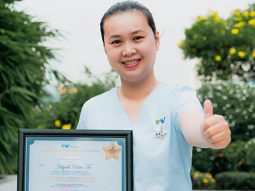The goals of hip and knee replacement surgery are to relieve pain, increase mobility, and improve or restore normal joint functions. Diseased or damaged parts of the hip or the knee joint are removed and replaced with artificial implants called prosthetic devices.
FV Hospital boasts a very high rate of successful outcomes for hip and knee replacement surgery and this is due to several factors:
- Training and experience: Dr Phat is an orthopaedic surgeon Board-certified in Germany, who has performed more than 900 hip and 800 knee replacements in his career, including 350 at FV since 2010. Patients are typically in their sixties but some were as young as 16-year old and a number were more than 90-year old.
- Precise implant indication: Dr Phat can offer the right prosthetic device for each patient based on anatomy, function and patient’s preferences. All prosthetic devices used at FV Hospital are US- or European Union-certified
- Minimally invasive techniques: they require special dexterity and skill. Dr Phat routinely performs these procedures using the Bauer approach for the hip and the Midvastus approach for the knee. Preserving the muscular function (muscles are not cut) allows for a rapid recovery
- Meticulous infection control: patients are given antibiotics both prior to and after surgery. Additionally, special precautions are taken in the operating room for skin preparation, draping, and instrument preparation. The infection rate at FV Hospital for these types of procedures is less than 1% which is in line with the best centres in the world
- Prevention of Deep Vein Thrombosis: at FV hospital, one or more types of treatments, such as blood thinning medications, early mobilization and physical therapy, range-of-motion exercises, elastic stockings, and intermittent pneumatic compression devices “ACCEL® Technology” (Active Compression and Cold Exchange Loop) are available to prevent blood clots
- Post-operative pain control: using Morphine IV-PCA (Patient-controlled analgesia via intravenous route) for hip replacement and continuous peripheral nerve block under ultrasound guidance for knee replacement to achieve effective pain control in post-operative period, and “Game Ready” cryotherapy to decrease swelling
- Immediate rehabilitation and short length of hospitalisation: patients start walking on the day after surgery helped by the physiotherapist and are discharged usually at day 6 or 7 capable of walking independently with a frame or crutches. Patients can walk unaided after 4 to 6 weeks, and can swim after 2 weeks or use a bicycle after 5 to 6 weeks.
- Rehabilitation: the rehabilitation process plays a crucial role in helping patients get back on their feet and resume an active lifestyle. FV Hospital physiotherapists follow specialised knee or hip replacement rehabilitation protocols. Usually patients require 4 to 6 weeks of physiotherapy in the Rehabilitation Department
- Surgeon follow-up: all patients are seen regularly after discharge by their orthopaedic surgeon (at one week, 6 weeks, 6 months, 1 year, and 5 years)

 Vi
Vi 












